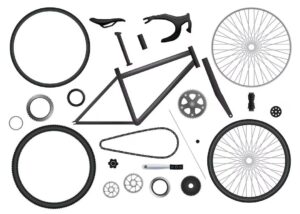يعد التساؤل عن حجم إطار الدراجة المناسب للارتفاع أمرًا بالغ الأهمية للحصول على تجربة ركوب ممتعة. إن الحجم المناسب لإطار الدراجة هو أكثر من مجرد مسألة راحة - فهو ضروري للسلامة, أداء, والاستمتاع الشامل بتجربة ركوب الدراجات الخاصة بك. يضمن إطار الدراجة ذو الحجم المناسب تمديد الساق بشكل مناسب, وصول مريح إلى المقاود, وخصائص التعامل الأمثل. في هذا الدليل الشامل, سوف نتعمق في تعقيدات تغيير حجم إطار الدراجة, تزويدك بفهم واضح لكيفية اختيار المقاس المثالي الذي يناسب طولك وأسلوب ركوبك.

شرح حجم إطار الدراجة

تتراوح أحجام إطارات الدراجة عادةً من الصغيرة جدًا إلى الكبيرة جدًا, مع قياسات تعتمد على عوامل مختلفة مثل طول أنبوب المقعد, طول الأنبوب العلوي, وارتفاع الوقوف. يعد فهم هذه القياسات أمرًا أساسيًا للعثور على الحجم المناسب لجسمك.
كم بوصة هو إطار دراجة كبير?
تتراوح إطارات الدراجة الكبيرة عادةً من 19 ل 21 بوصات, اعتمادا على الشركة المصنعة والنموذج المحدد. لكن, من الضروري ملاحظة أن أحجام الإطارات يمكن أن تختلف بين العلامات التجارية, لذلك من الضروري استشارة مخطط المقاسات الخاص بالشركة المصنعة للحصول على قياسات دقيقة.
كم بوصة هو إطار الدراجة المتوسطة?
تتراوح إطارات الدراجة المتوسطة عمومًا من 17 ل 19 بوصة في الحجم. مرة أخرى, يمكن أن تختلف هذه القياسات قليلاً حسب العلامة التجارية وطراز الدراجة.
كم بوصة هو إطار دراجة صغيرة?
تتراوح إطارات الدراجة الصغيرة عادةً من 15 ل 17 بوصات, مما يجعلها مناسبة للراكبين ذوي الدرزات الداخلية الأقصر أو أولئك الذين يفضلون إطارًا أكثر إحكاما.
ما هو حجم الدراجة الذي أحتاجه لطولي؟? وأوضح الرسم البياني
الحجم المناسب لإطار الدراجة لا يتعلق فقط بالراحة; يتعلق الأمر بتحسين أدائك وضمان قيادة سلسة في كل مرة تضغط فيها على الطريق أو الطريق. لذلك, توفر معظم الشركات المصنعة لإطارات الدراجة مخططات للحجم تربط حجم الإطار بارتفاع الراكب, مما يجعل من السهل العثور على المقاس المثالي. فيما يلي مخطط حول ارتفاع الراكب وحجم إطار الدراجة المقترح وفقًا لأبحاث السوق.
| ارتفاع الراكب (قدم/بوصة) | حجم إطار الدراجة الموصى به (بوصات) |
| 4'10” – 5'2″ | 13″ – 15″ |
| 5'3″ – 5'6″ | 15″ – 17″ |
| 5'7″ – 5'10” | 17″ – 19″ |
| 5'11” – 6'2″ | 19″ – 21″ |
| 6'3″ وما فوق | 21″ وما فوق |
ما هو حجم الإطار الذي أحتاجه إذا كان مقاسي بين الأحجام؟?
عندما تجد نفسك في تلك المنطقة الصعبة بين أحجام إطارات الدراجة, لا تقلق! هناك بعض الاستراتيجيات التي يجب وضعها في الاعتبار.
أولاً, اختبار الخاص بك “يصل”. يصل, الطول الذي تشعر به الدراجة عندما تكون في وضع الركوب, يعتمد على طول الجزء العلوي من جسمك, ويعرف أيضًا باسم طول صندوق السيارة الخاص بك. اختر الحجم الأكبر إذا كان طول صندوق السيارة أطول من المتوسط. على العكس, إذا كان أقصر, اذهب للحجم الأصغر. يضمن هذا النهج الشخصي أن تبدو دراجتك وكأنها امتداد لك, ليس لغزا لحله.
ثم, فكر في أسلوب ركوبك وتفضيلاتك. إذا كنت تميل نحو خفة الحركة والقدرة على المناورة, قد يكون التحجيم هو الطريق الصحيح. بدلاً عن ذلك, إذا كان الاستقرار والراحة هما أهم أولوياتك, التحجيم يمكن أن يكون الجواب.
قم بتجربة تعديلات السرج والمقود لضبط مقاسك, ولا تتردد في طلب المشورة من خبراء الدراجات للحصول على إرشادات شخصية.
كيف يتم قياس حجم إطار الدراجة؟?
يتم عادةً قياس أحجام إطارات الدراجة من منتصف الدعامة السفلية إلى أعلى أنبوب المقعد. هذا القياس, المعروف باسم طول أنبوب المقعد, هو المؤشر الأساسي لحجم الإطار.
لقياس ذلك بدقة, ستحتاج إلى شريط قياس. ابدأ من منتصف الدعامة السفلية — المكون الأسطواني الذي يربط مجموعة الكرنك — ثم قم بتمديد الشريط عموديًا إلى الجزء العلوي من أنبوب المقعد, حيث يدخل عمود المقعد إلى الإطار. هذا القياس, يتم التعبير عنها عادة بالبوصات أو السنتيمترات, يحدد حجم الإطار ويساعدك في العثور على المقاس المثالي لاحتياجات الركوب الخاصة بك.
كيفية الحصول على حجم الدراجة المناسب?
عندما يتعلق الأمر بحجم إطار الدراجة المناسب لعميلك, أنها تنطوي على أكثر من مجرد النظر إلى القياسات. يتطلب الحجم المثالي للدراجة مراعاة عوامل مختلفة, مصممة لعملائك’ الاحتياجات. دعونا نستكشف كيفية اتخاذ القرار الصحيح:
النظر في حجم الإطار
ارجع إلى مخططات الحجم أو استشر الخبراء لمطابقة عملائك’ الارتفاع إلى حجم الإطار المناسب. على سبيل المثال, قد يختار الدراجون الأكثر خبرة إطارًا أكبر, الاستفادة من زيادة الاستقرار أثناء الهبوط عالي السرعة. لكن, قد يجد الراكب الجديد إطارًا أكبر ساحقًا, مما يؤثر على سيطرتهم وثقتهم بالدراجة. لتلبية الاحتياجات المختلفة لمختلف العملاء, TP-140009, إطار دراجة مصنوع من الكربون الفاخر صممه تألق قريبا, تفتخر 3 خيارات حجم الإطار, بما في ذلك 15″, 17″, و 19″. سواء كان عملاؤك مبتدئين أو قدامى المحاربين, لقد غطى هذا الإطار الكثير.
النظر في هندسة الإطار
تؤثر هندسة الإطار بشكل كبير على شعور الدراجة وأدائها. يسمح اختبار ركوب النماذج المختلفة لعملائك بتجربة كيفية توافق هندسة الإطار مع جسمك وأسلوب الركوب بشكل مباشر. على سبيل المثال, يوفر الإطار الأكبر بقاعدة عجلات أطول وقمرة قيادة أكثر اتساعًا إحساسًا مستقرًا مناسبًا لمواقف الركوب العدوانية. على الجانب الآخر, قد يوفر الإطار الأصغر معالجة ذكية ووضعية ركوب أكثر استرخاءً, مثالية لراكبي الدراجات العاديين.
النظر في مستوى المهارة
عملاؤك’ يعد مستوى المهارة أمرًا بالغ الأهمية أيضًا في اختيار حجم الدراجة المناسب. قد ينجذب الدراجون المهرة نحو الإطارات الأكبر حجمًا, الاستفادة من الاستقرار المعزز عند السرعات العالية. لكن, قد يجد راكبو الدراجات الأقل خبرة إطارات أكبر تمثل تحديًا للمناورة والتحكم, مما يؤدي إلى عدم الراحة والمخاوف المحتملة المتعلقة بالسلامة.
فكر في أسلوب الركوب
قم بتخصيص حجم دراجتك ليتناسب مع أسلوب الركوب المفضل لديك. قد يكون الإطار الأكبر الذي يتمتع بقدر كبير من الخلوص والثبات مثاليًا إذا كنت تستمتع بمعالجة المسارات الفنية بمناورات عدوانية. على العكس, إذا كنت تفضل الإبحار على طول المسارات المريحة مع دفعات سريعة من حين لآخر, قد يكون الإطار الأصغر الذي يوفر معالجة سريعة الاستجابة أكثر ملاءمة.
النظر في حجم العجلة
بينما تتميز معظم الدراجات بأحجام عجلات قياسية, قد تقوم بعض العلامات التجارية بتجهيز إطارات أصغر بعجلات أصغر نسبيًا. توفر العجلات الأكبر مقاس 29 بوصة زخمًا وثباتًا ممتازين لمعظم البالغين. لكن, قد يجد الدراجون الصغار صعوبة في المناورة, اختيار أحجام عجلات أصغر لتحسين التحكم وخفة الحركة.
خاتمة
أساسيات حجم إطار الدراجة بالنسبة للارتفاع هي الأساس للركوب بثقة. من خلال فهم كيفية مطابقة طولك مع حجم الإطار المناسب, والنظر في عوامل مثل حجم الإطار والهندسة, أسلوب الركوب, ومستوى المهارة, يمكنك مساعدة عملائك على ضمان التوافق التام. خذ الوقت الكافي لاستكشاف الخيارات, التشاور مع الخبراء, وإعطاء الأولوية للراحة والأداء على الطريق أو الممر.

















